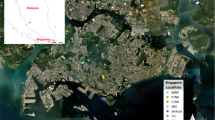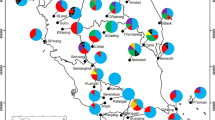Abstract
Taxus chinensis and T. wallichiana in have been threatened in their distribution areas in recent decades because of their over-exploitation and reduction and destruction of native habitats. Determining the genetic diversity in populations of the two species will provide guidelines for their protection and preservation. Two hundred and fifteen trees from six populations of T. chinensis and 150 sampled trees of T. wallichiana were sampled. Six microsatellite primer pairs selected from 16 primer pairs were used to investigate genetic variation at the population and species levels. Five yielded polymorphic alleles, and among the 13 putative alleles amplified, 11 were polymorphic (accounting for 76.33 %).Shannon’s information index (I) and percentage of polymorphic bands (PPB) (I = 0.202 and PPB = 67.22 % for T. chinensis; I = 0.217 and PPB = 65.03 % for T. wallichiana). Both species had low levels of genetic diversity (mean H o = 0.107, H e = 0.121 for T. chinensis; H o = 0.095, H e = 0.109 for T. wallichiana). Genetic differentiation among populations was higher (F ST = 0.189) for T. chinensis and lower (0.156) for T. wallichiana, indicating limited gene flow (Nm) among populations for T. chinensis (0.68) and T. wallichiana (0.65). Variation among individuals of T. chinensis was 63.59 and 73.12 % for T. wallichiana. Thus, the threatened status of the two conifers is related to a lack of genetic diversity. All populations are isolated in small forest remnants. An ex situ conservation site should be established with a new population for these species that comprises all the genetic groups for the best chance to improve their fitness under environmental stresses.




Similar content being viewed by others
References
Aquirre Planter E, Furnier GR, Eguiarte LE (2000) Low levels genetic variation within and high levels of genetic differentiation among populations of species of Abies from southern Mexico and Guatemala. Am J Bot 87:362–371
Barrett SCH, Kohn JR (1991) Genetic and evolutionary consequences of small population size in plants: implications for conservation. In: Falk DA, Holsinger KE (eds) Genetics and conservation of rare plants. Oxford University Press, Oxford, pp 3–30
Boy J, Cherry M, Dayanandan S (2005) Microsatellite analysis reveals genetically distinct populations of red pine (Pinus resinosa, Pinaceae). Am J Bot 92:833–841
Cipriano J, Carvalho A, Fernandes C, Gaspar MJ (2013) Evaluation of genetic diversity of Portuguese Pinus sylvestris L. populations based on molecular data and inferences about the future use of this germplasm. J Genet 92:e41–e48
Doyle JJ, Doyle JJ (1990) Isolation of plant DNA from fresh tissue. Pocus 12:13–15
Dubreuil M, Sebastiani F, Mayol M, Gonza´lez-Martı´nez SC, Riba M, Vendramin GG (2008) Isolation and characterization of polymorphic nuclear microsatellite loci in Taxus baccata L. Conserv Genet 9:1665–1668
Earl DA, von-Holdt BM (2012) Structure Harvester: a website and program for visualizing structure output and implementing the Evanno method. Conserv Genet Resour 4:359–361
Echt CS, May Marquardt P, Hseih M, Zahorchak R (1996) Characterization of microsatellite markers in eastern white pine. Genome 39:1102–1108
Ellstrand NC, Elam RD (1993) Population genetic consequences of small population size: implication for plant conservation. Ann Rev Ecol Syst 24:217–242
Evanno G, Regnaut S, Goudet J (2005) Detecting the number of clusters of individuals using the software structure: a simulaton study. Mol Ecol 14:2611–2620
Excoffier L, Laval G, Schneider S (2005) Arlequin v. 3.1. an integrated software package for population genetics data analysis. Evol Bioinform 1:47–50
Farjon A, Page CN (1999) Conifers status survey and conservation action plans. IUCNISSC. Conifer Specialist Group IUCN, Cambridge
Hiep NT, Loc PK, Luu NDT, Thomas T, Farjon A, Averyanov I, Regalado J (2004) Vietnam conifers. Conservation status review 2004. Fauna and Flora international, Vietnam Program, Hanoi, p 128
Ho¨hn M, A´bra´n P, Vendramin (2005) Genetic analysis of Swiss stone pine populations (Pinus cembra L. subsp. cembra) from the Carpathians using chloroplast microsatellites. Acta Silvatica et Ligniensia Hungarica 1:39–47
Huang CC, Chiang TY, Hsu TW (2008) Isolation and characterization of microsatellite loci in Taxus sumatrana (Taxaceae) using PCR-based isolation of microsatellite arrays (PIMA). Conserv Genet 9:471–473
Karp A (1997) Molecular tools in plant genetic resources conservation: a guide to the technologies. Bioversity International, Rome
Larionova AY, Ekart AK, Kravchenko AN (2007) Genetic diversity and population structure of Siberian fir (Abies sibirica LEDER.) in Middle Siberia, Russia. Eurasian J For Res 10:185–192
Luu NDT, Thomas P (2004) Conifers of Vietnam. Agricultural Publishing, Hanoi
Miao YC, Su JR, Zhang ZJ, Li H, Luo J, Zhang YP (2008) Isolation and characterization of microsatellite markers for the endangered Taxus yunnanensis. Conserv Genet 9:1683–1685
Miller MP (1997) Tools for population genetic analysis (TFPGA) 1.3: a windows program for the analysis of allozyme and molecular population genetic data
MOST, VAST (2007) Vietnam red data book, part II. plants. Natural Sciences and Technology, Hanoi
Nei M (1972) Genetic distance between populations. Am J Bot 72:1590–1597
Peakall R, Smouse PE (2006) GENALEX 6: genetic analysis in Excel. Population genetic software for teaching and research. Mol Ecol Notes 6:288–295
Phong DT, Lieu TT, Hien VTT, Hiep NT (2015) Genetic diversity of the endemic flat needle pine Pinus krempfii (Pinaceae) from Vietnam revealed by SSR markers. Genet Mol Res 14(3):7727–7739
Pritchard JK, Stephens M, Donnelly P (2000) Inference of population structure using multilocus genotype data. Genetics 155:945–959
Rubio Moraga A, CandelPerez D, LucasBorja ME, Tiscar PA (2012) Genetic diversity of Pinus nigra Arn. populations in southern Spain and northern Morocco revealed by inter-simple sequence repeat profiles. Int J Mol Sci 13:5645–5658
Slatkin M (1985) Gene flow in natural populations. Ann Rev Ecol Syst 16:393–430
Smith DN, Devey ME (1994) Occurrence and inheritance of microsatellites in Pinus radiata. Genome 37:977–983
Nguyen MT, Vu DD, Bui TTX, Nguyen MD (2013) Genetic variation and population structure in Chinese water pine (Glyptostrobus pensilis): a threatened species. Indian J Biotechnol 12(4):499–503
Terrab A, Paun O, Talavera S, Tremetsberger K, Arista M, Stuessy TF (2006) Genetic diversity and population structure in natural populations of Moroccan Atlas cedar (Cedrus atlantica, Pinaceae) determined with cpSSR markers. Am J Bot 93:1274–1280
Thomas P, Nguyen TH, Phan KL, Nguyen QH (2013) The IUCN Red List of Threatened Species. Version 2015.2. www.iucnredlist.org. Accessed 6 July 2015
Turner IM (2001) The ecology of trees in the tropical rain forest. Cambridge University Press, Cambridge
Van NK, Hien NT, Loc PK, Hiep NT (2000) Bioclimatic diagrams of Vietnam. National University Publishing House, Hanoi, p 124
Vendramin GG, Lelli L, Rossi P, Morgante M (1996) A set of primers for the amplification of 20 chloplast microsatellites in Pinaceae. Mol Ecol 5:595–598
Vendramin GG, Anzidei M, Madaghiele A, Bucci C (1998) Distribution of genetic diversity in Pinus pinaster Ait. as revealed by chloroplast microsatellites. Theor Appl Genet 97:456–463
Xue H, Lu CH, Wu XB (2012) Development and characterization of microsatellite markers for the endangered Chinese yew Taxus chinensis var. mairei (Taxaceae). Genet Mol Res 11(2):1296–1299
Yang JB, Li HT, Li DZ, Liu J, Gao L-M (2009) Isolation and characterization of microsatellite markers in the endangered species Taxus wallichiana using the FIASCO method. HortScience 44(7):2043–2045
Author information
Authors and Affiliations
Corresponding author
Additional information
Project funding: This work was supported by a research project (No. Z111021402) of Northwest A&F University and by the Ministry of Natural Resources and Environment, Vietnam government, Hanoiand IDEA WILD equipment to Vu Dinh Duy, Bui Thi Tuyet Xuan.
The online version is available at http://www.springerlink.com
Corresponding Editor: Yu Lei.
Rights and permissions
About this article
Cite this article
Vu, D.D., Bui, T.T.X., Nguyen, M.T. et al. Genetic diversity in two threatened species in Vietnam: Taxus chinensis and Taxus wallichiana . J. For. Res. 28, 265–272 (2017). https://doi.org/10.1007/s11676-016-0323-1
Received:
Accepted:
Published:
Issue Date:
DOI: https://doi.org/10.1007/s11676-016-0323-1




